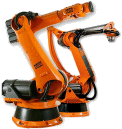This article has multiple issues. Please help improve it or discuss these issues on the talk page . (Learn how and when to remove these messages)
|

Factory automation infrastructure describes the process of incorporating automation into the manufacturing environment and processing input goods into final products. [1] [2] Factory automation intends to decrease risks associated with laborious and dangerous work faced by human workers. [3] [4]
Contents
The manufacturing environment is defined by its ability to manufacture and/or assemble goods by machines, integrated assembly lines, and robotic arms. Automated environments are also defined by their coordination with (and usually their systematic integration with) the required automatic equipment to form a complete system. [5]
